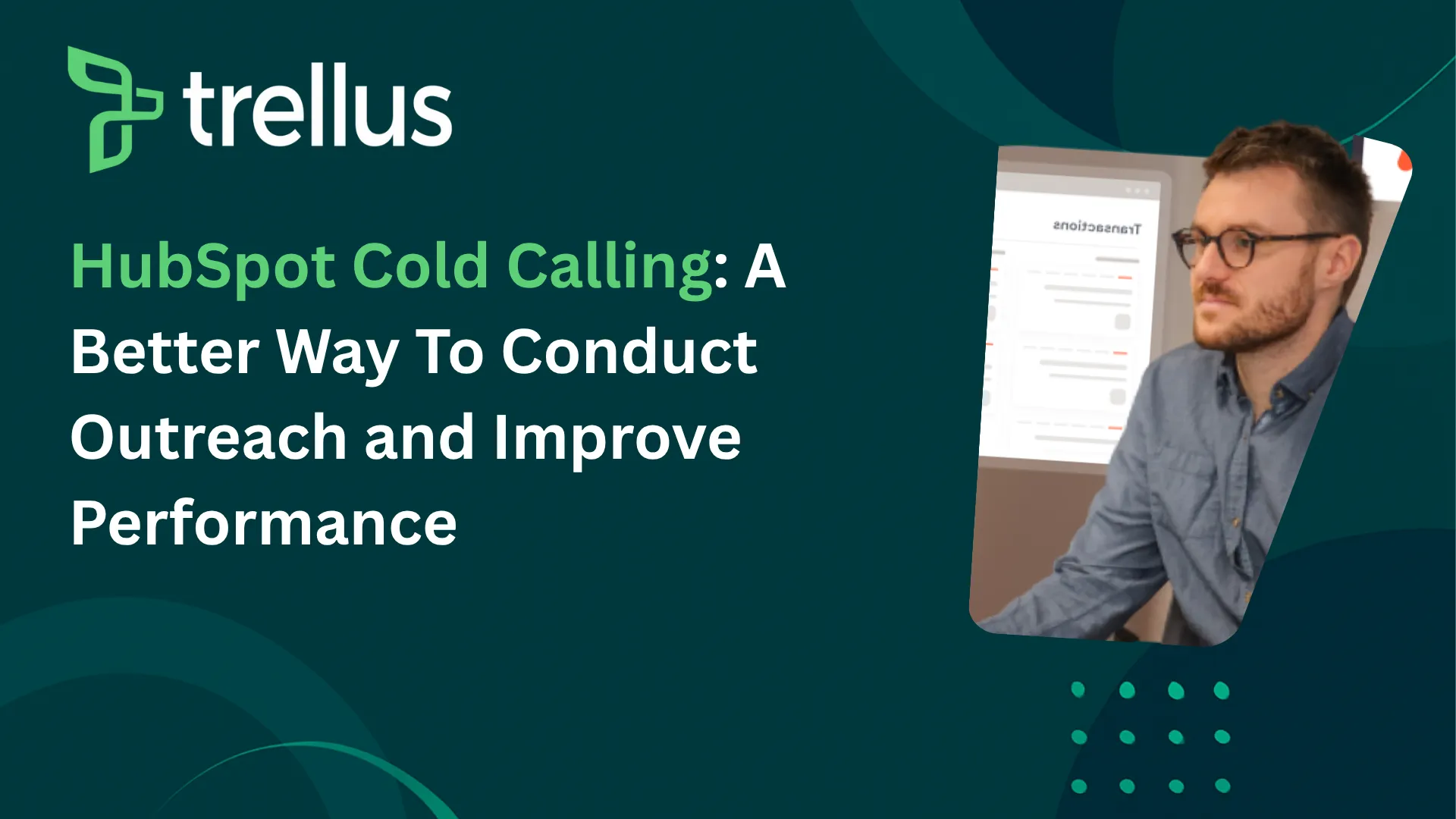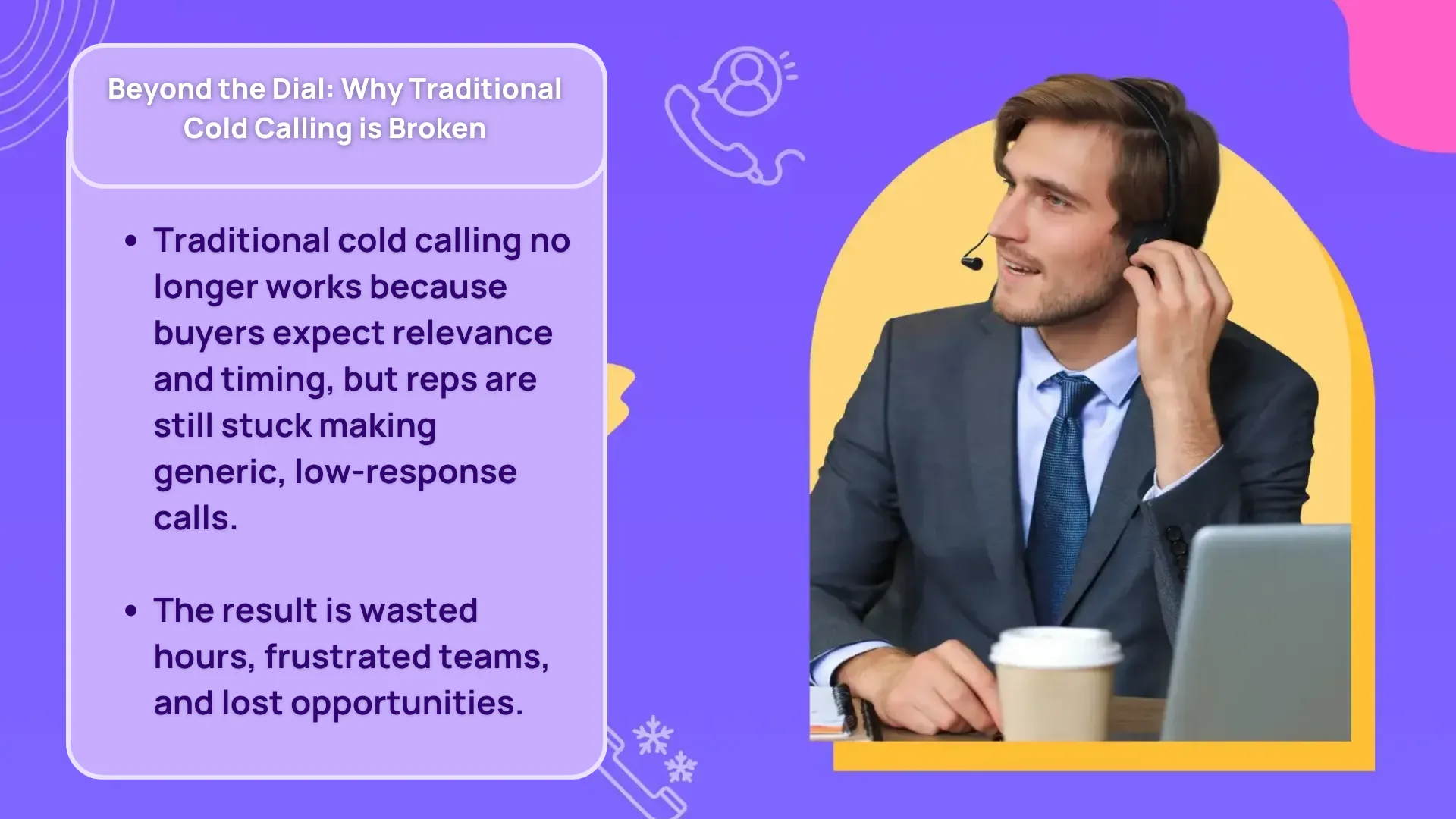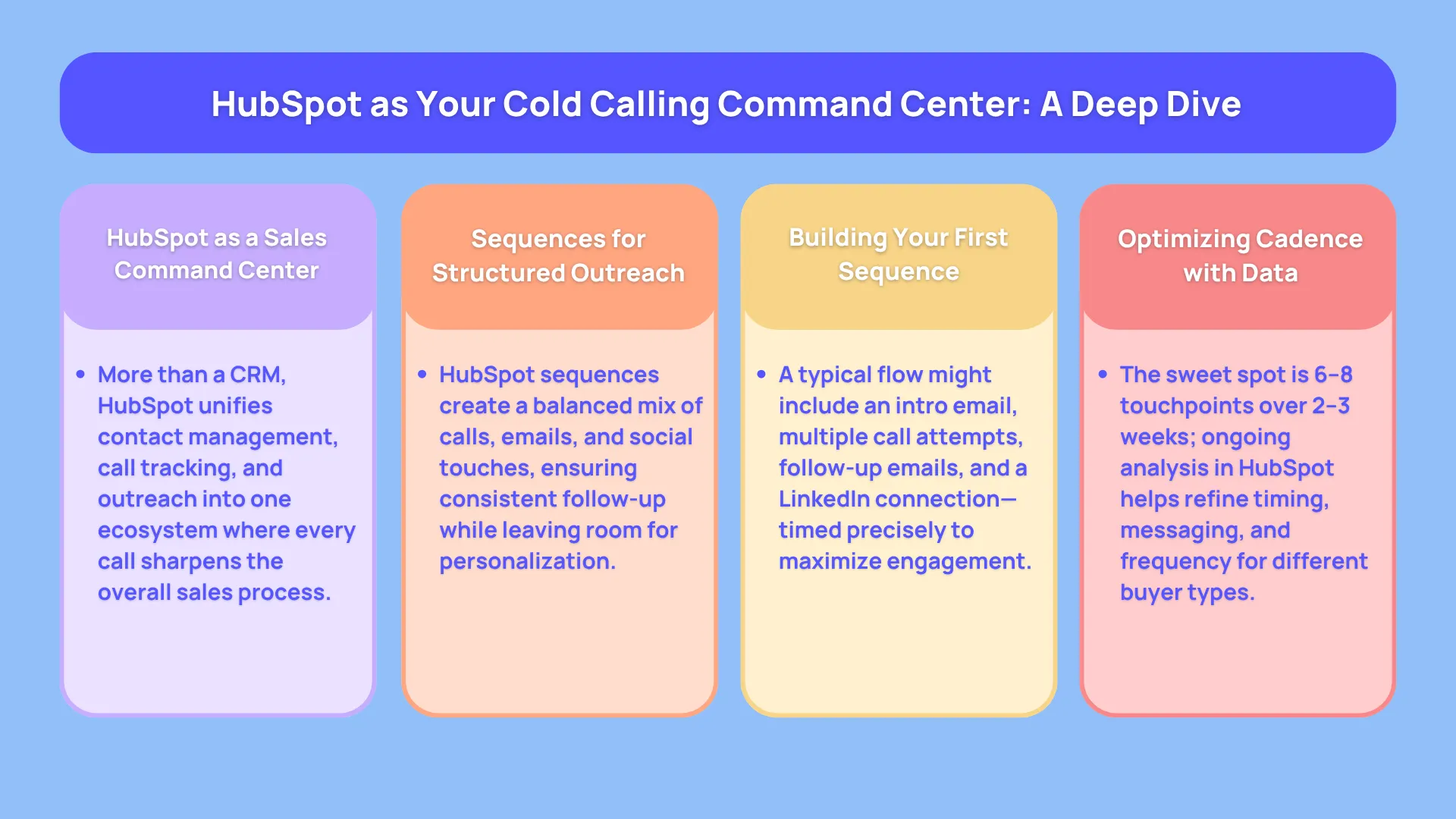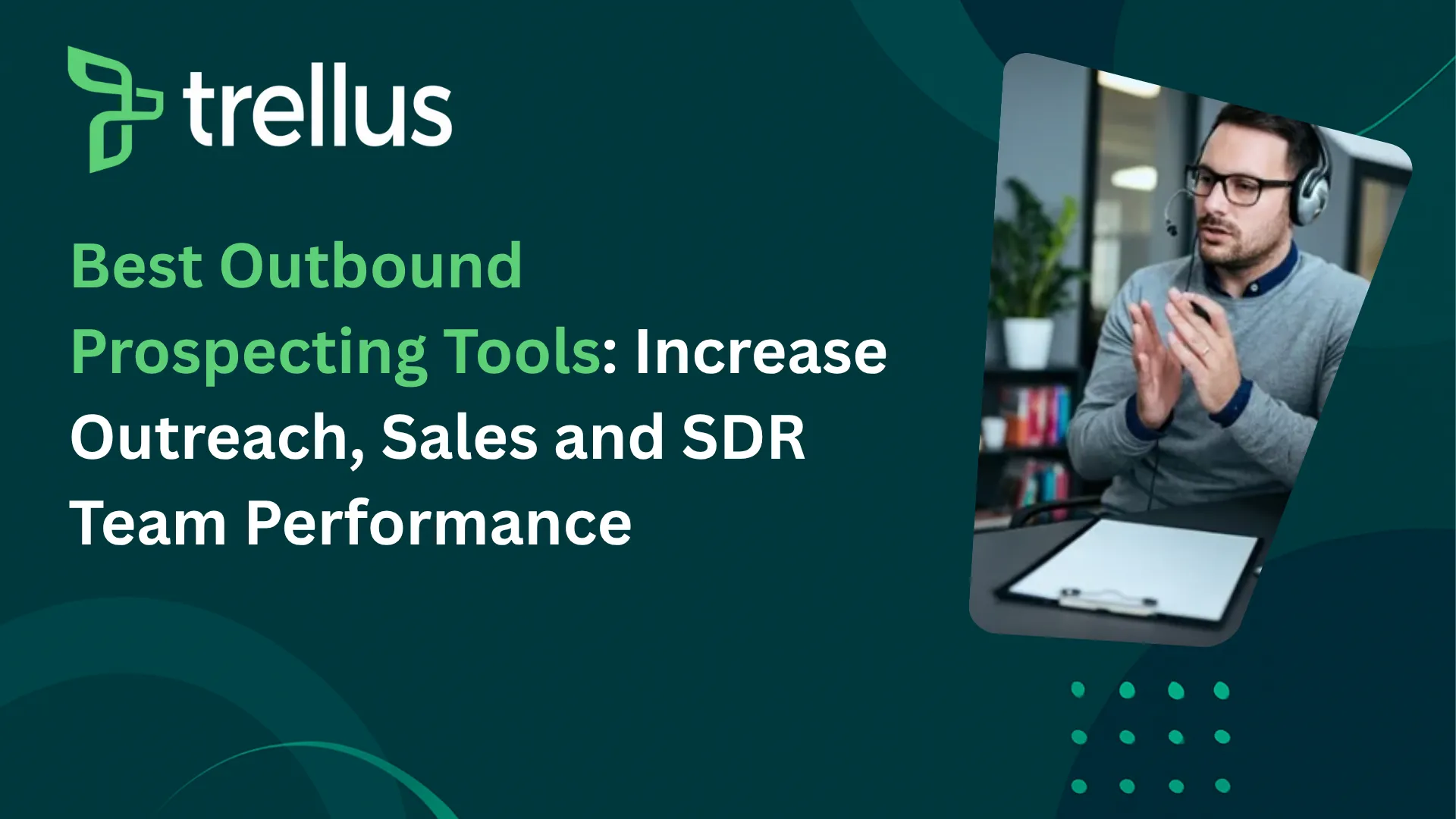
Our Top Picks


Cold calling has always carried a reputation for being a high-pressure, numbers-driven game.
The old model was simple: more dials meant more chances, and sales leaders pushed teams to crank through lists without much thought about who was on the other end.
It worked to a point, but it also burned out reps, frustrated prospects, and delivered shrinking returns over time.
Today, the shift is clear. Cold calling isn’t about sheer volume anymore—it’s about precision. Sales organizations are learning that the quality of outreach matters more than quantity.
The biggest driver of that change? Technology. Artificial intelligence and platforms like HubSpot have rewritten the rules. Instead of guessing who to call or when, teams can rely on data, predictive scoring, and integrated workflows that tee up the right conversation at the right time.
That doesn’t mean cold calling is dead.
On the contrary, if you were to think outside the box, you’d know that it is more alive than ever.
But it no longer resembles the boiler-room setups of the past. Modern outreach is personalized, intelligent, and built on insights rather than hunches.
On that note, based on our experience in the sales industry, we’d say that the SDR teams who lean into this shift are having better conversations, booking more meetings, and feeling less like robots reading from a script.
Also Read:
The reality is simple: the phone is still powerful.
But in today’s environment, the phone works best as part of a coordinated, multi-channel strategy supported by a CRM like HubSpot. And when cold calling blitzes are powered by the right data and tools, they turn into well-orchestrated campaigns instead of frantic dialing sessions.
Beyond the Dial: Why Traditional Cold Calling is Broken

Traditional cold calling hit its limits long ago. Answer rates are painfully low, gatekeepers block access, and personalization is nearly impossible at scale without the right tech. What you get is wasted hours, frustrated reps, and a pile of missed opportunities.
The real problem is that the approach hasn’t kept up with how buyers operate today.
Buyers expect relevance and timing, not generic pitches that could apply to anyone. This mismatch between how sales reps call and how buyers engage is why the old cold outreach strategies no longer deliver meaningful ROI.
The AI-Powered Advantage: How Technology is Reshaping Sales Outreach
The game-changer has been AI and automation. Instead of dialing blindly, reps now have tools that flag who’s most likely to pick up, which accounts fit the ICP, and even the best time of day to call. Sequences can be personalized at scale, letting a rep sound relevant without writing everything from scratch.
HubSpot plays a central role here. With built-in automation, advanced sales enablement tools, and integrations for enrichment and dialing, it turns cold calling into a smarter, data-backed process. Reps no longer have to choose between speed and quality—they can have both.
HubSpot as Your Cold Calling Command Center: A Deep Dive

For many sales teams, HubSpot is thought of as just a CRM. In reality, it’s a complete command center for running modern cold calling campaigns.
Every element, starting from the way contacts are organized, to how sequences are launched, to the insights collected from call tracking, feeds into a single ecosystem.
That means sales reps and their respective managers can work off one source of truth, and every call contributes to a more refined approach over time.
Mastering HubSpot Sales Sequences for Personalized Outreach
Sequences are where HubSpot shines in turning a cold call into part of a bigger strategy. Instead of leaving reps to figure out their own mix of calls, emails, and LinkedIn touches, sequences create structure while still allowing room for personalization.
A well-built HubSpot sequence ensures prospects don’t just hear from you once and then disappear. It creates a cadence that increases the chance of connection without overwhelming the contact.
Timing matters—too fast and you look pushy, too slow and you lose momentum.
Reps can insert personalization tokens, tailor messaging based on deal stage, or adjust based on a prospect’s previous engagement. With HubSpot logging every touchpoint, managers can see what works and refine over time.
Building Your First HubSpot Sales Sequence
Creating a sequence in HubSpot starts in the Sales Hub.
Sales representatives can set up a step-by-step plan: an intro email, a phone call two days later, a LinkedIn touch after that, and so on.
Each step is scheduled with precision, and HubSpot handles the reminders so nothing slips.
A basic cold calling sequence might look like this:
- Day 1: Intro email
- Day 2: Cold call attempt #1
- Day 4: Follow-up email
- Day 6: Cold call attempt #2
- Day 8: LinkedIn connect request
- Day 10: Final call + value-driven message
This structure gives reps multiple shots without coming across as spammy.
Optimizing Your Sales Cadence for Maximum Impact
No sequence is perfect on the first try.
In that order, it requires practice and a consistent approach with a minimum backlog.
Over time, you’ll start noticing that the best results come from watching the data. How many touches is too many? Which emails lead to callbacks? Are calls better in the morning or the afternoon?
Best practices point to 6–8 touchpoints spread across 2–3 weeks as the sweet spot. Spacing touches by 1–3 days helps balance persistence with patience. Over time, data from HubSpot shows where prospects are most responsive, and you can fine-tune cadences for different buyer personas or industries.
Leveraging HubSpot Call Tracking for Actionable Insights
One of HubSpot’s underrated strengths is call tracking. Reps can make calls directly through the CRM, track outcomes, and analyze patterns—all without juggling spreadsheets or external tools. Every call is logged automatically, with outcomes categorized through call disposition tracking.
For managers, this is gold. You can see not just how many calls are being made, but what those calls are producing. Connection rates, objection trends, and time-to-conversation all become measurable. Instead of coaching in the dark, managers can zero in on exactly where reps need support.
Setting Up and Using HubSpot Call Tracking
Getting started is straightforward. Teams can purchase a HubSpot tracking number, assign it to reps, and connect it to the HubSpot calling feature. From there, calls can be placed directly inside HubSpot, with outcomes logged automatically.
This setup eliminates the old “forgot to log my call” problem and ensures accurate data. Calls can also be recorded, creating a library of real conversations that managers can use for training.
Analyzing Call Data to Improve Performance
Once data flows in, the real value emerges. Key metrics include:
- Call volume – how many calls are being made per rep.
- Connection rate – how many calls result in live conversations.
- Call outcomes – meetings booked, follow-ups scheduled, objections logged.
Managers can spot patterns: perhaps mornings are better for one vertical, or a certain script produces higher conversions. These insights turn coaching sessions into data-driven conversations that actually move the needle.
Trellus: The No.1 HubSpot Sales Automation and AI-Powered Dialer

Cold calling, especially when you’re looking to dial from within a CRM, like HubSpot, isn’t easy.
There are technical complexities that tend to be counter productive and time consuming. That’s where our platform comes in.
Trellus employs a blend of latest tech tools and artificial intelligence to ensure leads reach the best possible rep based on multiple data points:
- Lead priority scoring – Hot leads (recent email engagers, high-intent website visitors) jump to the front of the queue.
- Rep specialization – Enterprise leads automatically route to senior account executives, while SMB leads go to high-volume closers.
- Availability-based routing – Calls only go to reps who are active and ready, eliminating missed connections.
- Performance-based matching – Leads are assigned to reps with the highest historical conversion rates for similar profiles.
As a result, this dynamic routing system ensures that no lead slips through the cracks, unlike static distribution methods used in different platform integrations.
Zero Manual Dialing, Zero CRM Admin Work
Trellus removes the friction of manual processes by automating every step:
- One-click dialing from HubSpot – Reps initiate calls directly from contact records without switching apps.
- Automatic call logging – Dispositions, notes, and outcomes are recorded instantly in HubSpot.
- Smart voicemail detection – The system identifies unanswered calls and schedules follow-ups at optimal times.
- Seamless call recording storage – Every conversation is transcribed and attached to the correct HubSpot contact record.
These automations save reps 1-2 hours daily, allowing them to focus purely on selling rather than administrative tasks.
3. AI-Powered Real-Time Sales Coaching
Unlike old-school integrations that many modern CRMs still employ, Trellus has a dedicated layer of latest features alongside conversational AI, monitoring and sales reps’ performance tracking modules to improve and scale your overall business.
In addition to that, we also offer some of the best features, such as the following, to native HubSpot users:
- Talk-time analysis – Alerts reps when they dominate conversations, prompting them to ask more questions.
- Objection handling suggestions – Recommends proven responses when buyers raise concerns.
- Next-step AI based prompts – Suggests ideal follow-ups based on call outcomes.
Teams using Trellus report 37% better pitch adherence and 28% shorter sales cycles due to this real-time coaching.
Smarter Prospecting: Finding the Right People to Call (*At The Right Time!)
Even the best cold call is wasted on the wrong person.
The foundation of every successful blitz is prospect quality, and this is where HubSpot’s prospecting tools change the game. Instead of random lists, reps can work off carefully curated contacts that fit the ICP and show real buying intent.
Beyond the Basics: Advanced Prospecting with HubSpot
Basic contact details aren’t enough anymore.
HubSpot allows teams to go deeper with custom objects, firmographic filters, and predictive lead scoring. Combined with third-party data integrations, reps can prioritize prospects who look like existing best customers.
Imagine being able to flag prospects at companies that just raised funding, or individuals who recently engaged with your marketing content. That’s where HubSpot’s prospecting tools excel: turning static lists into living, dynamic queues that adapt in real time.
Defining Your Ideal Customer Profile in HubSpot
The first step is clarity. Who’s most likely to buy from you?
In HubSpot, you can analyze your closed-won deals to identify patterns: company size, industry, decision-maker title, or even specific technologies in use.
From there, build lists and workflows that surface prospects matching those traits. That way, every cold call is targeted toward someone with a higher likelihood of interest.
Using Lead Scoring to Prioritize Your Outreach
Lead scoring adds another layer of intelligence. Within HubSpot, you can assign points for demographic fit (title, company size), firmographic alignment (industry, revenue), and behavioral engagement (website visits, email clicks).
The result is a ranked list where high-scoring prospects get priority attention in your blitz. Reps don’t waste time on low-fit contacts, and managers can be confident the team is chasing the right opportunities.
The Role of the Sales Development Representative (SDR) in Modern Prospecting
SDRs have evolved from list grinders to strategic prospectors.
Their job is more than just dialing prospects.
In the current landscape, it’s about interpreting signals, qualifying leads, and shaping the pipeline for AEs. With HubSpot at their fingertips, SDRs can see engagement histories, lead scores, and ICP alignment before they ever pick up the phone.
This shift demands new skills. Reps need to be comfortable with data analysis, CRM navigation, and value-driven messaging. It’s not just about persistence anymore—it’s about intelligence.
Equipping Your SDRs for Success
The right tools are non-negotiable.
SDRs should have access to HubSpot Sales Hub, enrichment data providers, and enablement platforms with call recordings and talk tracks. Just as important is ongoing training—role-plays, objection handling practice, and coaching sessions based on real call data.
The SDR as a Strategic Partner
When SDRs are empowered, they become more than appointment setters.
They surface market feedback, flag common objections, and highlight shifting trends. This intelligence helps AEs refine pitches and gives leadership early warning signals about changing buyer behavior. In short, SDRs become a vital partner in shaping sales strategy.
The Pre-Blitz Checklist: Preparing for Success
Preparation sets the stage. Before a single dial happens, make sure these elements are in place:
- Target list – cleaned, segmented, and aligned with ICP.
- Sales sequences – mapped out with calls, emails, and social touches.
- Call scripts – concise, value-driven, and tailored by persona.
- Dialer setup – integrated with HubSpot for efficiency.
- Coaching resources – talk tracks, objection guides, and call libraries.
With this checklist, reps start with confidence and managers know the campaign is structured for success.
Crafting Compelling Cold Calling Scripts
A good script balances structure with flexibility.
The best openings reference relevance (“I noticed your team is hiring SDRs; congrats”) instead of generic greetings.
A clear value proposition should follow within 30 seconds, and every script should end with a direct next step, such as booking time for a deeper conversation.
Choosing the Right Sales Dialer Software
A dialer multiplies productivity. Power dialers help reps move through lists quickly, while predictive dialers optimize connect rates by dialing multiple numbers simultaneously. HubSpot integrates with both types, allowing call activity and outcomes to log directly into the CRM.
During the Blitz: Best Practices for Real-Time Execution
Once the blitz starts, structure is everything. Reps should block out time for calling without distractions, handle objections with empathy, and adjust messaging based on real-time feedback from prospects.
Managers play an active role too. They can monitor call outcomes in HubSpot, jump into live coaching sessions, and adjust sequences mid-campaign if needed.
Time Management for Maximum Productivity
Reps who time block calling hours—typically mornings and late afternoons—see higher connect rates. Techniques like the Pomodoro Method keep energy high, while silencing notifications ensures full focus during blitz sessions.
Handling Objections with Grace and Skill
Objections are part of the game. Instead of pushing back, top reps listen actively, acknowledge concerns, and pivot toward value.
A simple framework: listen, validate, reframe, and ask a question. For example, “I understand you already have a solution—many of our customers felt the same way before realizing we solved X gap.
Out of curiosity, how do you handle Y today?”
Measuring and Optimizing Your Blitzes for Continuous Improvement
The beauty of running blitzes in HubSpot is that everything is trackable. With data at your fingertips, you don’t just measure performance—you improve it with every campaign.
Key Metrics to Track in HubSpot
The most important metrics fall into two buckets:
- Activity metrics: calls made, emails sent, connection attempts.
- Effectiveness metrics: meetings booked, conversion rates, opportunities created.
Both matter, but effectiveness is the true measure of success.
Activity Metrics vs. Effectiveness Metrics
High call volume means nothing if no meetings are booked. Activity shows effort; effectiveness shows impact. Sales leaders should encourage both but reward outcomes.
Building a HubSpot Dashboard for Cold Calling
Within HubSpot, managers can build dashboards that display key metrics in real time. Reports might include call volume by rep, meetings booked, connection rates, and conversion by sequence. Having this visibility makes it easy to coach in the moment instead of waiting for end-of-month reviews.
Continuous Improvement: The A/B Testing Mindset
The most advanced teams treat cold calling like marketing: always testing, always optimizing. Different openings, varied cadences, and alternative CTAs can all be tested in real campaigns.
A/B Testing Your Scripts and Cadences
Set up two variations, run them across similar prospect groups, and track which one drives higher connect rates or bookings. Over time, these small improvements compound into significant gains.
The Role of Sales Coaching in Optimization
Numbers tell part of the story, but coaching fills in the gaps. Reviewing call recordings in HubSpot allows managers to give targeted feedback: tone, pacing, and objection handling.
Over time, reps sharpen their skills while campaigns become more effective.
It’s an Evolving Phenomenon
Cold calling isn’t dying; it’s transforming. What once was a brute-force numbers game is now a precision-driven process backed by AI, data, and platforms like HubSpot.
Teams that treat blitzes as coordinated campaigns rather than random dialing sessions see better results, happier reps, and more booked meetings.







